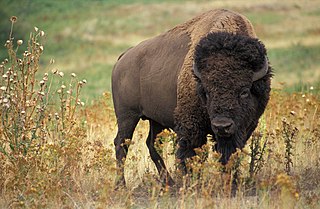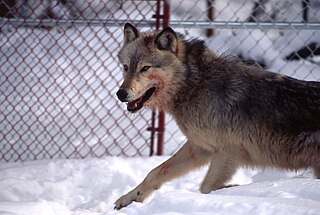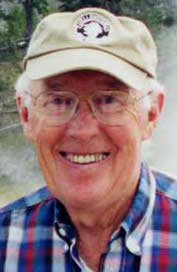
The American bison, also called the American buffalo or simply buffalo, is a species of bison native to North America. It is one of two extant species of bison, alongside the European bison. Its historical range, by 9000 BCE, is described as the great bison belt, a tract of rich grassland that ran from Alaska to the Gulf of Mexico, east to the Atlantic Seaboard, as far north as New York, south to Georgia, and according to some sources, further south to Florida, with sightings in North Carolina near Buffalo Ford on the Catawba River as late as 1750.

The UC Berkeley College of Chemistry is one of the fifteen schools and colleges at the University of California, Berkeley. It houses the department of chemistry and the department of chemical and biomolecular engineering, both of which are ranked among the best in the world. Its faculty and alumni have won 18 Nobel Prizes, 9 Wolf Prizes, and 11 National Medals of Science.

The Greater Yellowstone Ecosystem (GYE) is one of the last remaining large, nearly intact ecosystems in the northern temperate zone of the Earth. It is located within the northern Rocky Mountains, in areas of northwestern Wyoming, southwestern Montana, and eastern Idaho, and is about 22 million acres (89,000 km2). Yellowstone National Park and the Yellowstone Caldera 'hotspot' are within it.

Sir Arthur George Tansley FLS, FRS was an English botanist and a pioneer in the science of ecology.

The Hokkaido wolf, also known as the Ezo wolf and in Russia as the Sakhalin wolf, is an extinct subspecies of gray wolf that once inhabited coastal northeast Asia. Its nearest relatives were the wolves of North America rather than Asia. It was exterminated in Hokkaido during the Meiji Restoration period, when American-style agricultural reforms incorporated the use of strychnine-laced baits to kill livestock predators. Some taxonomists believe that it survived up until 1945 on the island of Sakhalin. It was one of two subspecies that were once found in the Japanese archipelago, the other being the Japanese wolf.
Ecology is a new science and considered as an important branch of biological science, having only become prominent during the second half of the 20th century. Ecological thought is derivative of established currents in philosophy, particularly from ethics and politics.

An apex predator, also known as a top predator, is a predator at the top of a food chain, without natural predators of its own.

The northwestern wolf, also known as the Mackenzie Valley wolf, Alaskan timber wolf, or Canadian timber wolf, is a subspecies of gray wolf in western North America. Arguably the largest gray wolf subspecies in the world, it ranges from Alaska, the upper Mackenzie River Valley; southward throughout the western Canadian provinces, aside from prairie landscapes in its southern portions, as well as the Northwestern United States.

Wolf reintroduction involves the reintroduction of a portion of grey wolves in areas where native wolves have been extirpated. More than 30 subspecies of Canis lupus have been recognized, and grey wolves, as colloquially understood, comprise nondomestic/feral subspecies. Reintroduction is only considered where large tracts of suitable wilderness still exist and where certain prey species are abundant enough to support a predetermined wolf population.
The Journal of Cell Science is a peer-reviewed scientific journal in the field of cell biology. The journal is published by The Company of Biologists. The journal is partnered with Publons, is part of the Review Commons initiative and has two-way integration with bioRxiv. Journal of Cell Science is a hybrid journal and publishes 24 issues a year. Content over 6 months old is free to read.

Thomas Dale Brock was an American microbiologist known for his discovery of hyperthermophiles living in hot springs at Yellowstone National Park. In the late 1960s, Brock discovered high-temperature bacteria living in the Great Fountain region of Yellowstone, and with his colleague Hudson Freeze, they isolated a sample which they named Thermus aquaticus. "Life at High Temperatures", a 1967 article summarizing his research, was published in the journal Science and led to the study of extremophiles, organisms that live in extreme environments. By 1976, T. aquaticus was found useful for artificially amplifying DNA segments. Brock's discoveries led to great progress in biology, contributed to new developments in medicine and agriculture, and helped create the new field of biotechnology.

The history of wolves in Yellowstone includes the extirpation, absence and reintroduction of wild populations of the gray wolf to Yellowstone National Park and the Greater Yellowstone Ecosystem. When the park was created in 1872, wolf populations were already in decline in Montana, Wyoming and Idaho. The creation of the national park did not provide protection for wolves or other predators, and government predator control programs in the first decades of the 1900s essentially helped eliminate the gray wolf from Yellowstone. The last wolves were killed in Yellowstone in 1926. After that, sporadic reports of wolves still occurred, but scientists confirmed that sustainable wolf populations had been extirpated and were absent from Yellowstone during the mid-1900s.

The bibliography of Yellowstone National Park identifies English language historic, scientific, ecological, cultural, tourism, social, and advocacy books, journals and studies on the subject of Yellowstone National Park topics published since 1870 and documented in Yellowstone related bibliographies and other related references.
In ecology, a priority effect refers to the impact that a particular species can have on community development as a result of its prior arrival at a site. There are two basic types of priority effects: inhibitory and facilitative. An inhibitory priority effect occurs when a species that arrives first at a site negatively affects a species that arrives later by reducing the availability of space or resources. In contrast, a facilitative priority effect occurs when a species that arrives first at a site alters abiotic or biotic conditions in ways that positively affect a species that arrives later. Inhibitory priority effects have been documented more frequently than facilitative priority effects. Studies indicate that both abiotic and biotic factors can affect the strength of priority effects. Priority effects are a central and pervasive element of ecological community development that have significant implications for natural systems and ecological restoration efforts.

The northern Rocky Mountain wolf, also known as the northern Rocky Mountain timber wolf, is a subspecies of gray wolf native to the northern Rocky Mountains. It is a light-colored, medium to large-sized subspecies with a narrow, flattened frontal bone. The subspecies was initially listed as Endangered on March 9, 1978, but had the classification removed in the year 2000 due to the effects of the Northern Rocky Mountain Wolf Recovery Plan. On August 6, 2010, the northern Rocky Mountain wolf was ordered to be returned under Endangered Species Act protections by U.S. District Judge Donald Molloy in a decision overturning a previous ruling by the U.S. Fish and Wildlife Service. They were later removed on August 31, 2012 from the list because of Idaho, Montana, and Wyoming meeting the population quotas for the species to be considered stable. This wolf is recognized as a subspecies of Canis lupus in the taxonomic authority Mammal Species of the World (2005).

The ecology of the Rocky Mountains is diverse due to the effects of a variety of environmental factors. The Rocky Mountains are the major mountain range in western North America, running from the far north of British Columbia in Canada to New Mexico in the southwestern United States, climbing from the Great Plains at or below 1,800 feet (550 m) to peaks of over 14,000 feet (4,300 m). Temperature and rainfall varies greatly also and thus the Rockies are home to a mixture of habitats including the alpine, subalpine and boreal habitats of the Northern Rocky Mountains in British Columbia and Alberta, the coniferous forests of Montana and Idaho, the wetlands and prairie where the Rockies meet the plains, a different mix of conifers on the Yellowstone Plateau in Wyoming, the montane forests of Utah, and in the high Rockies of Colorado and New Mexico, and finally the alpine tundra of the highest elevations.
Monica G. Turner is an American ecologist known for her work at Yellowstone National Park since the large fires of 1988. She is currently the Eugene P. Odum Professor of Ecology at the University of Wisconsin–Madison.
Mark Stephen Boyce is a professor of population ecology in the University of Alberta Department of Biological Sciences, and the Alberta Conservation Association Chair in Fisheries and Wildlife. Among other topics, he has written extensively on population viability analysis and resource selection functions. Early work was on demography and life history evolution. In 1993 he began research on habitat selection and the integration of habitats with population biology. He initiated research on elk in the Greater Yellowstone Ecosystem in 1977 and in 1988 was recruited by the National Park Service to build a simulation model to anticipate the consequences of wolf reintroduction in Yellowstone National Park. These simulation models were published by Yellowstone National Park to justify the ultimate release of wolves in 1995. Several graduate students and postdoctoral fellows continued the Yellowstone work. After moving to the University of Alberta in 1999 most research has been on mammals and birds in Alberta.
Frank Cooper Craighead Jr. and John Johnson Craighead, twin brothers, were American conservationists, naturalists, and researchers who made important contributions to the studies of falconry and grizzly bear biology. The brothers were born in Washington, D.C., where both graduated from Western High School in 1935. The brothers began collecting and identifying animals and plants they found alongside the Potomac and soon expanded their interests to birds and hawks. They traveled west in 1934 to begin studying falconry. After World War II, during which they were employed as survival trainers, they each married and resumed their work in falconry. During the 1950s, the Craighead brothers expanded their work to other animals, including many species living in and around Yellowstone, and eventually separated.
J.V. Durden was a British filmmaker and biologist. He is the person who created the term 'Ciné-biology', or 'the study of life through the medium of the cinema'. He described himself as a 'ciné-biologist', or 'scientist-filmmaker', and spent his life making highly detailed, technically intricate, lab-created films, where photography took place under a microscope. He brought the art of cinemicrography to Canada and became the co-founder of the Science Film Section at the National Film Board of Canada.













